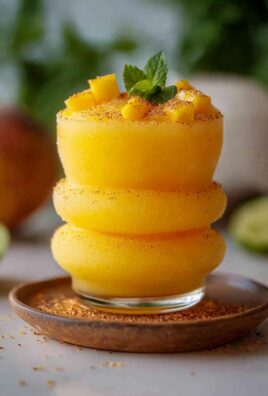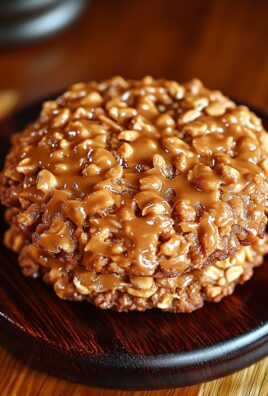Turkish Almond Pudding, or Ke?kül as it’s known in Turkey, is a dessert that whispers of Ottoman palaces and centuries of culinary tradition. Imagine a creamy, subtly sweet almond-infused dream, delicately perfumed with rosewater and garnished with pistachios. Sounds divine, doesn’t it? This isn’t just a pudding; it’s an experience, a taste of history served in a bowl.
Ke?kül has a rich history, believed to have originated in the kitchens of the Topkapi Palace, where it was prepared for sultans and their entourages. It was often distributed to the poor during Ramadan, embodying the spirit of generosity and sharing. The name itself, “Ke?kül,” refers to the beggar’s bowl, further emphasizing this connection to charity and community.
But beyond its historical significance, Turkish Almond Pudding is simply irresistible. People adore its smooth, velvety texture and the delicate balance of flavors. The almond provides a subtle nuttiness, while the rosewater adds a touch of floral elegance. It’s a dessert that’s both comforting and sophisticated, perfect for ending a special meal or enjoying as a sweet treat any time of day. Plus, it’s surprisingly easy to make at home, allowing you to bring a taste of Turkish royalty to your own kitchen!
Ingredients:
- 1 liter (4 cups) whole milk
- 1 cup blanched almonds, finely ground
- 1 cup granulated sugar
- 1/4 cup cornstarch
- 1/4 cup rice flour
- 1 teaspoon almond extract
- 1/4 teaspoon salt
- Ground cinnamon, for garnish
- Slivered almonds, for garnish
Preparing the Almond Mixture:
Okay, let’s get started! The key to a smooth and delicious Turkish Almond Pudding (Kazandibi’s cousin, but without the burnt bottom!) is to ensure our almond mixture is perfectly blended. We’re aiming for a creamy, dreamy texture, so pay close attention to this first step.
- Grinding the Almonds: First things first, make sure your blanched almonds are finely ground. I prefer using a food processor for this, as it gives the most consistent results. Pulse the almonds until they resemble a fine powder. Be careful not to over-process, or you’ll end up with almond butter! If you don’t have a food processor, you can use a high-powered blender, but you might need to scrape down the sides more frequently. The finer the grind, the smoother your pudding will be.
- Combining Dry Ingredients: In a medium-sized bowl, whisk together the ground almonds, granulated sugar, cornstarch, rice flour, and salt. This ensures that the dry ingredients are evenly distributed, preventing any lumps from forming later on. The rice flour adds a lovely subtle texture to the pudding, so don’t skip it!
Creating the Pudding Base:
Now for the magic! This is where we transform our dry mixture into a luscious, creamy pudding. Patience is key here, as we want to avoid any scorching or lumps. Low and slow is the name of the game!
- Heating the Milk: Pour the whole milk into a large, heavy-bottomed saucepan. The heavy bottom is crucial to prevent scorching. Heat the milk over medium heat until it’s just about to simmer. You’ll see small bubbles forming around the edges, but don’t let it boil! Boiling the milk can alter its flavor and texture.
- Tempering the Almond Mixture: This is a crucial step to prevent lumps! Take about 1 cup of the warm milk and slowly drizzle it into the bowl with the almond mixture, whisking constantly. Continue whisking until the mixture is smooth and lump-free. This process is called tempering, and it gradually raises the temperature of the almond mixture, preventing it from seizing up when added to the hot milk.
- Combining Everything: Slowly pour the tempered almond mixture into the saucepan with the remaining warm milk, whisking constantly. Make sure to scrape the bottom and sides of the bowl to get every last bit of that almond goodness!
Cooking the Pudding:
This is where the real work begins! We need to cook the pudding until it thickens to the perfect consistency. This requires constant stirring and a watchful eye. Don’t be tempted to walk away, or you might end up with a lumpy, burnt mess!
- Constant Stirring: Reduce the heat to low and continue to cook the pudding, stirring constantly with a whisk or a wooden spoon. Make sure to scrape the bottom and sides of the saucepan to prevent sticking and scorching. This is a bit of an arm workout, but trust me, it’s worth it!
- Achieving the Right Consistency: Cook the pudding for about 20-30 minutes, or until it has thickened to the consistency of a thick custard. You should be able to coat the back of a spoon with it, and when you run your finger through it, the line should hold its shape. The pudding will continue to thicken as it cools, so don’t overcook it!
- Adding Almond Extract: Once the pudding has reached the desired consistency, remove it from the heat and stir in the almond extract. The almond extract enhances the almond flavor and adds a lovely aroma. Be careful not to add too much, as it can be overpowering.
Cooling and Serving:
Almost there! Now we just need to let the pudding cool and set before we can enjoy it. This is the hardest part, I know, but patience is a virtue!
- Pouring into Serving Dishes: Pour the pudding into individual serving dishes or a large serving bowl. I like to use small ramekins for individual portions, but you can use whatever you have on hand.
- Cooling to Room Temperature: Let the pudding cool to room temperature. This will take about an hour or two.
- Refrigerating: Once the pudding has cooled to room temperature, cover it with plastic wrap, pressing it directly onto the surface to prevent a skin from forming. Refrigerate for at least 4 hours, or preferably overnight, to allow it to fully set.
- Garnishing and Serving: Before serving, garnish the pudding with ground cinnamon and slivered almonds. The cinnamon adds a warm, spicy note, while the slivered almonds provide a nice crunch. You can also add other toppings, such as chopped pistachios, shredded coconut, or fresh berries. Serve chilled and enjoy!
Tips for Success:
- Use Whole Milk: Whole milk provides the richest flavor and creamiest texture.
- Grind Almonds Finely: The finer the grind, the smoother the pudding.
- Stir Constantly: This prevents sticking and scorching.
- Don’t Overcook: The pudding will continue to thicken as it cools.
- Refrigerate Thoroughly: This allows the pudding to fully set.
Variations:
- Rosewater: Add a teaspoon of rosewater along with the almond extract for a floral twist.
- Orange Blossom Water: Substitute orange blossom water for the almond extract for a citrusy aroma.
- Chocolate: Add a tablespoon of cocoa powder to the dry ingredients for a chocolate almond pudding.
- Spices: Add a pinch of cardamom or nutmeg for a warm, spicy flavor.
I hope you enjoy this recipe for Turkish Almond Pudding! It’s a simple yet elegant dessert that’s perfect for any occasion. Let me know in the comments if you try it and how it turns out!

Conclusion:
And there you have it! These Fried Sweet Dough Balls are more than just a dessert; they’re a little bite of happiness, a warm hug on a plate, and a guaranteed crowd-pleaser. I truly believe this recipe is a must-try for anyone who loves simple pleasures and the joy of homemade goodness. The slightly crispy exterior giving way to a soft, pillowy interior, dusted with sweet powdered sugar it’s an experience your taste buds won’t soon forget.
But why is this recipe so special? It’s the perfect balance of ease and deliciousness. You don’t need to be a seasoned baker to whip up a batch of these beauties. The ingredients are readily available, the instructions are straightforward, and the results are consistently amazing. Plus, the aroma that fills your kitchen as they fry is simply intoxicating! It’s the kind of smell that evokes memories of childhood fairs and cozy family gatherings.
Beyond the sheer deliciousness, these Fried Sweet Dough Balls are incredibly versatile. Looking for serving suggestions? Oh, the possibilities are endless! Serve them warm with a scoop of vanilla ice cream and a drizzle of chocolate sauce for an extra indulgent treat. Or, pair them with a cup of strong coffee or tea for a delightful afternoon snack. They’re also fantastic dipped in Nutella, fruit preserves, or even a simple glaze made with powdered sugar and milk.
Want to get creative with variations? Go for it! Try adding a pinch of cinnamon or nutmeg to the dough for a warm, spicy flavor. You could also incorporate mini chocolate chips or chopped nuts for added texture and richness. For a citrusy twist, add some lemon or orange zest to the dough. And if you’re feeling adventurous, try filling them with a dollop of jam or cream cheese before frying. The only limit is your imagination!
I’m confident that once you try this recipe, it will become a staple in your kitchen. It’s perfect for potlucks, parties, or simply a sweet treat for yourself. Imagine the smiles on your friends’ and family’s faces when you present them with a plate of these golden, sugary delights. It’s a surefire way to brighten anyone’s day.
So, what are you waiting for? Gather your ingredients, preheat your oil, and get ready to embark on a culinary adventure. I promise you won’t be disappointed. This recipe for Fried Sweet Dough Balls is a winner, plain and simple.
And now, for the most important part: I want to hear about your experience! Did you try the recipe? Did you make any variations? What did your family and friends think? Share your photos, comments, and stories in the comments section below. I’m eager to see your creations and learn from your experiences. Let’s build a community of sweet dough ball enthusiasts!
Don’t be shy give this recipe a try and let me know what you think. Happy frying! I hope these Fried Sweet Dough Balls bring as much joy to your kitchen as they have to mine. I can’t wait to hear all about your sweet success!
Turkish Almond Pudding: A Delicious and Easy Recipe
Creamy Turkish Almond Pudding with a smooth texture and delicate almond flavor. Easy to make and perfect for any occasion!
Ingredients
- 1 liter (4 cups) whole milk
- 1 cup blanched almonds, finely ground
- 1 cup granulated sugar
- 1/4 cup cornstarch
- 1/4 cup rice flour
- 1 teaspoon almond extract
- 1/4 teaspoon salt
- Ground cinnamon, for garnish
- Slivered almonds, for garnish
Instructions
- Finely grind blanched almonds using a food processor or high-powered blender until they resemble a fine powder. Be careful not to over-process into almond butter.
- In a medium bowl, whisk together ground almonds, granulated sugar, cornstarch, rice flour, and salt until evenly distributed.
- Pour whole milk into a large, heavy-bottomed saucepan. Heat over medium heat until just about to simmer (small bubbles forming around the edges). Do not boil.
- Take about 1 cup of the warm milk and slowly drizzle it into the bowl with the almond mixture, whisking constantly until smooth and lump-free.
- Slowly pour the tempered almond mixture into the saucepan with the remaining warm milk, whisking constantly. Scrape the bottom and sides of the bowl to get all the almond mixture.
- Reduce the heat to low and continue to cook the pudding, stirring constantly with a whisk or a wooden spoon. Make sure to scrape the bottom and sides of the saucepan to prevent sticking and scorching.
- Cook the pudding for about 20-30 minutes, or until it has thickened to the consistency of a thick custard. You should be able to coat the back of a spoon with it, and when you run your finger through it, the line should hold its shape.
- Once the pudding has reached the desired consistency, remove it from the heat and stir in the almond extract.
- Pour the pudding into individual serving dishes or a large serving bowl.
- Let the pudding cool to room temperature. This will take about an hour or two.
- Once the pudding has cooled to room temperature, cover it with plastic wrap, pressing it directly onto the surface to prevent a skin from forming. Refrigerate for at least 4 hours, or preferably overnight, to allow it to fully set.
- Before serving, garnish the pudding with ground cinnamon and slivered almonds. Serve chilled and enjoy!
Notes
- Use whole milk for the richest flavor and creamiest texture.
- Grind almonds as finely as possible for a smoother pudding.
- Stir constantly during cooking to prevent sticking and scorching.
- Don’t overcook the pudding; it will continue to thicken as it cools.
- Refrigerate thoroughly to allow the pudding to fully set.





Leave a Comment